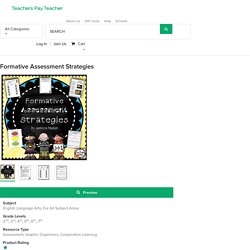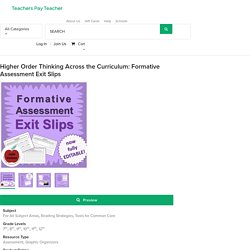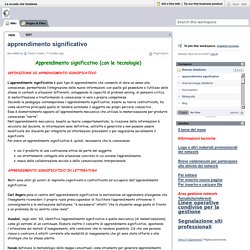

Formative assessment is assessment designed to help improve student’s performance.

Formative assessment usually involves giving students constructive feedback and is given throughout the learning process unlike summative assessment which is given to assess a student’s performance at the end of their learning. Formative assessment is meant to give students feedback throughout their learning while there is still room for improvement. Formative assessment should focus on: -Student progress and growth and should also clarify what good performance looks like. -Encouraging motivation and self esteem -Encouraging conversations about learning between students, peers, and teachers. And lastly provide information to help shape teaching and learning. This resource includes 20 different EDITABLE exit slips you can use as formative assessments and reading checks in any content area.

I used similar exit slips as a reading teacher, but as a literacy coach, I realized that teachers across the curriculum could use a similar tool--especially as increased reading demands are knocking at our doors. In addition to the exit slips themselves (two on each page), I've included a general explanation/introduction, seven pages of instructions and tips on how to use each of the slips, a chart identifying which CCSS could be met by each technique, and a page of labels so you can make your own little basket with dividers for easy access in your classroom (see thumbnail). La scuola che funziona / apprendimento significativo. Apprendimento significativo (con le tecnologie) L’apprendimento significativo è quel tipo di apprendimento che consente di dare un senso alle conoscenze, permettendo l’integrazione delle nuove informazioni con quelle già possedute e l’utilizzo delle stesse in contesti e situazioni differenti, sviluppando la capacità di problem solving, di pensiero critico, di metariflessione e trasformando le conoscenze in vere e proprie competenze.

Secondo la pedagogia contemporanea l'apprendimento significativo, basato su teorie costruttiviste, ha come obiettivo principale quello di rendere autonomo il soggetto nei propri percorsi conoscitivi . Esso è diametralmente opposto all'apprendimento meccanico che utilizza la memorizzazione per produrre conoscenza “inerte”. Per avere un apprendimento significativo è, quindi, necessario che la conoscenza: Molti sono stati gli autori di impronta cognitivista e costruttivista ad occuparsi dell'apprendimento significativo. 1. 2. 3. 4. 5.
Valutazione_Formativa_1.pdf. Writers_Toolkit.pdf. 39 07. 12 Awesome Formative Assessment Examples. Finding new and unique ideas for formative assessments is always a struggle. However, the team over at the Global Digital Citizen Foundation has some ideas in the following blog, originally posted on their site last April. Formative assessment tools used in the classroom provide critical feedback to teachers, helping them to monitor and modify their instruction methods and lesson plans. Teachers are better able to meet the unique needs of individual students, empowering them through personalized and timely feedback. It’s important to use a variety of teaching and learning formative assessments, changing them frequently to stimulate both students and teachers. Assessment techniques are only as limited as the teacher’s imagination! Here are 12 awesome formative assessment examples that we like. 1) Postcards From the Past 2) Collage or Poster Ask students to make a collage or poster from magazine photos to demonstrate understanding of a concept. 3) Journal 4) Doodle 5) Caption Photos.
Every Teacher’s Guide to Assessment. It’s not a stretch to say that assessment is a hot button issue in education; however, you’d be hard pressed to find an educator who doesn’t see the value in measuring student progress. Assessments themselves have been vilified, when, in fact, it’s why assessments are given and how the data is used that is really the issue. The Glossary of Education Reform gives this great overview of what high-stakes testing is and how it impacts students, teachers, and schools. Basically, high-stakes testing has consequences for the test-takers and givers—sometimes in the form of a high school diploma, grade advancement, and even teachers’ salaries. 50 Apps That Represent 50 New Ways To Learn – TeachThought. 50 Apps That Represent 50 New Ways To Learn by TeachThought Staff Modern learning is in a state of flux as it struggles to find out what it wants to become.

Schools continue to merely “add on” learning, while technology strongly suggests new possibilities for inside and beyond the classroom. From learning simulations and mobile learning, to adaptive apps, flipped classrooms, and self-directed learning through amazing digital channels, the possibilities for learning are almost overwhelming. Below we’ve gathered a diverse list of learning apps across iOS and Android from giants like Google, Apple, Microsoft, as well as upstarts like Brainfeed, The Sandbox, and Knowji. Learning through play.